
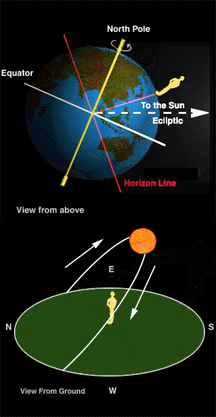


Solstices occur twice a year, when the tilt of the Earth's axis is oriented directly towards or away from the Sun, causing the Sun to reach its northernmost and southernmost extremes. The name is derived from the Latin sol (sun) and sistere (to stand still), because at the solstices, the Sun stands still in declination; that is, its apparent movement north or south comes to a standstill.
The term solstice can also be used in a wider sense, as the date (day) that such a passage happens. The solstices, together with the equinoxes, are connected with the seasons. In some languages they are considered to start or separate the seasons; in others they are considered to be centre points (in English, in the Northern hemisphere, for example, the period around the June solstice is known as midsummer, and Midsummer's Day is 24 June, about three days after the solstice itself). Similarly 25 December is the start of the Christmas celebration, which was a Pagan festival in pre-Christian times, and is the day the sun begins to return back to the northern hemisphere.
The cause of the seasons is that the Earth's axis of rotation is not perpendicular to its orbital plane (the flat plane made through the center of mass (barycenter) of the solar system (near or within the Sun) and the successive locations of Earth during the year), but currently makes an angle of about 23.44 degrees (called the "obliquity of the ecliptic"), and that the axis keeps its orientation with respect to inertial space. As a consequence, for half the year (from around 20 March to 22 September) the northern hemisphere tips to the Sun, with the maximum around 21 June, while for the other half year the southern hemisphere has this distinction, with the maximum around 21 December. The two moments when the inclination of Earth's rotational axis has maximum effect are the solstices.
During the northern solstice the Sun appears to be directly overhead at noon for places situated at latitude 23.44 degrees north, known as the tropic of Cancer. Likewise during the southern solstice the same thing happens for latitude 23.44 degrees south, known as the tropic of Capricorn. All places on Earth in between these two latitudes are known as the tropics and will see the Sun in the zenith at least two days in the year. Also during the northern solstice places situated at latitude 66.56 degrees north, known as the Arctic Circle will see the Sun just on the horizon during midnight, and all places north of it will see the Sun above horizon for 24 hours. That is the midnight sun or midsummer-night sun or polar day. On the other hand, places at latitude 66.56 degrees south, known as the Antarctic Circle will see the Sun just on the horizon during midday, and all places south of it will not see the Sun above horizon at any time of the day. That is the polar night. During the southern solstice the effects on both hemispheres are just the opposite.
At the temperate latitudes, during summer the Sun remains longer and higher above the horizon, while in winter it remains shorter and lower. This is the cause of summer heat and winter cold.
The seasons are not caused by the varying distance of Earth to the Sun due to the orbital eccentricity of the Earth's orbit. This variation does make such a contribution, but is small compared to the effects of exposure because of Earth's tilt. Currently the Earth reaches perihelion at the beginning of January, which is during the northern winter and the southern summer. The Sun, being closer to Earth and therefore hotter, does not cause the whole planet to enter summer. Although it is true that the northern winter is somewhat warmer than the southern winter, the placement of the continents, ice-covered Antarctica in particular, may also play an important factor. In the same way, during aphelion at the beginning of July, the Sun is farther away, but that still leaves the northern summer and southern winter as they are with only minor effects.
Due to Milankovitch cycles, the Earth's axial tilt and orbital eccentricity will change over thousands of years. Thus in 10,000 years one would find that Earth's northern winter occurs at aphelion and its northern summer at perihelion. The severity of seasonal change - the average temperature difference between summer and winter in location - will also change over time because the Earth's axial tilt fluctuates between 22.1 and 24.5 degrees.
Cultural Aspects
Many cultures celebrate various combinations of the winter and summer solstices, the equinoxes, and the midpoints between them, leading to various holidays arising around these events. For the December solstice, Christmas is the most popular holiday to have arisen. In addition, Yalda, Saturnalia, Karachun, Hanukkah, Kwanzaa and Yule (see winter solstice for more) are also celebrated around this time. For the June solstice, Catholic and Nordic Protestant cultures celebrate the feast of St. John from June 23 to June 24 (see St. John's Eve, Ivan Kupala Day, Midsummer), while the Wiccan culture observes Litha or Summer Solstice. For the vernal (spring) equinox, several spring-time festivals are celebrated, such as the observance in Judaism of Passover. The autumnal equinox has also given rise to various holidays, such as the Jewish holiday of Sukkot. At the midpoints between these four solar events, cross-quarter days are celebrated.
In many cultures the solstices and equinoxes traditionally determine the midpoint of the seasons, which can be seen in the celebrations called midsummer and midwinter. Along this vein, the Japanese celebrate the start of each season with an occurrence known as Setsubun. In modern western culture, the solstices and equinoxes are instead designated the beginning of each season, as the cumulative cooling and warming that result from the tilt of the planet become most pronounced after the solstices.
In the Hindu calendar, two sidereal solstices are named Uttarayana and Dakshinayana. The former occurs around January 14 each year, while the latter occurs around July 14 each year. These mark the movement of the Sun along a sidereally fixed zodiac (precession is ignored) into Mesha, a zodiacal sign which corresponded with Aries about 285, and into Tula, the opposite zodiacal sign which corresponded with Libra about 285. Read more ...

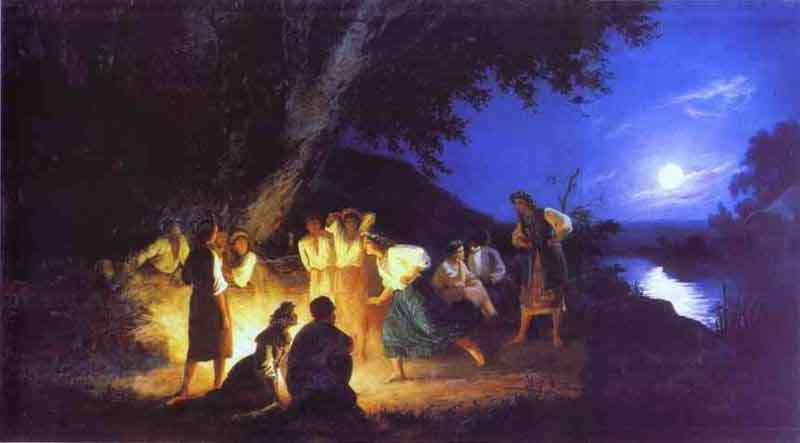
Midsummer, if it is previously specified, may refer to the period of time centered upon the summer solstice and the diverse celebrations of it around the world. However, the English term refers mostly to European celebrations that accompany the summer solstice, or to Western festivals that take place in June and are related to Saint John the Baptist. European midsummer-related holidays, traditions and celebrations, many of which are non-Christian in origin (although they are also called "St John's festivities"), are particularly important in Norway, Denmark, Sweden, Finland and Estonia, but found also in France, Italy, Portugal, in other parts of Europe and elsewhere (US, Canada, and even in the Southern Hemisphere (Brazil), where this European-born celebration should be more appropriately called Midwinter). Midsummer is also sometimes referred to as Litha; stemming from Bede's De temporum ratione in which he gave the Anglo-Saxon names for the months roughly corresponding to June and July.
Solstitial celebrations still centre upon 24 June, which is no longer the longest day of the year. The difference between the Julian calendar year (365.2500 days) and the tropical year (365.2422 days) moved the day associated with the actual astronomical solstice forward approximately three days every four centuries until Pope Gregory XIII changed the calendar bringing the solstice to around 21 June. In the Gregorian calendar, the solstice moves around a bit but in the long term it moves only about one day in 3000 years.
History
In the 7th century, Saint Eligius (died 659/60) warned the recently-Christianized inhabitants of Flanders against these pagan solstitial celebrations. According to the Vita by his companion Ouen, he would say:
As for his solsticial birthday, the Roman Catholic Church celebrates the Nativity of John the Baptist (June 24) as a Solemnity, which is the highest degree a liturgical feast can have. It is even one of the few saint's feasts that is celebrated even when it falls on a Sunday; typically the feast of a saint is superseded when it falls on a Sunday. There is hardly any way that the feast of St John the Baptist could be given more emphasis in the liturgical calendar.
The celebration of Midsummer's Eve was from ancient times linked to the summer solstice. People believed that mid-summer plants had miraculous and healing powers and they therefore picked them on this night. Bonfires were lit to protect against evil spirits which were believed to roam freely when the sun was turning southwards again. In later years, witches were also thought to be on their way to meetings with other evil powers.
In Sweden Mid-summer celebration originates from the time before Christianity; it was celebrated as a sacrifice time in the sign of the fertility.
The solstice itself has remained a special moment of the annual cycle of the year since Neolithic times. The concentration of the observance is not on the day as we reckon it, commencing at midnight or at dawn, but the pre-Christian beginning of the day, which falls on the previous eve. In Sweden, Finland and Estonia, Midsummer's Eve is considered the greatest festival of the year, comparable only with Walpurgis Night, Christmas Eve, and New Year's Eve.
France
In France, the "Fete de la Saint-Jean" (feast of St John), traditionally celebrated with bonfires (le feu de la Saint-Jean) that are reminiscent of Midsummer's pagan rituals, is a catholic festivity in celebration of Saint John the Baptist. It takes place on June 24, on Midsummer day (St John's day).
In most French villages, a tall bonfire is built by the inhabitants in order to be lit on St John's Day. In the Vosges region and in the Southern part of Meurthe-et-Moselle, this huge bonfire is named "chavande".
Quebec, Canada
In Quebec, Canada, the celebration of June 24 was brought to New France by the first French colonists. Great fires were lit at night. According to the Jesuit Relations, the first celebrations of St John's day in New France took place around 1638. In 1834, Ludger Duvernay, printer and editor of La Minerve took the leadership of an effort to make June 24 the national holiday of the Canadiens (French Canadians).
In 1908, Pope Pius X designated John the Baptist as the patron saint of the French-Canadians. In 1925, June 24 became a legal holiday in Quebec and in 1977, it became the secular National Holiday of Quebec. It still is the tradition to light great fires on the night of the 24th of June.
Portugal
In Portugal, Midsummer festivities are known today as "Santos Populares" (Popular Saints) and now correspond to different municipal holidays: St Anthony's Day in Lisbon (June 13), St John's Day in Oporto, Braga, and Almada (June 24). These holidays are days of festivities with good food and refreshments. The traditional midsummer bonfire is also built. In some places, revelers try to jump over the bonfire. In Lisbon, it is still the tradition to celebrate multiple marriages (200 to 300).
Brazil
The Portuguese Midsummer Day (St John's Day) brought to Brazil during colonial times has become a very important popular event that is celebrated during a period that starts one week before St John's Day and ends one week after. As this nationwide festival, called "Festa Junina" (Saint John Festival), happens during the European midsummer, it takes place in the Brazilian midwinter and is most associated with Northeastern Brazil, but today celebrated in the whole country.
As the northeast is largely arid or semi-arid these popular festivals not only coincide with the rainy seasons of most states in the northeast but they also provide the people with an opportunity to give thanks to Saint John for the rain. They also celebrate rural life and feature typical clothing, food, dance (particularly quadrilha, which is similar to square dancing). Like Midsummer and Saint John's Day in Portugal and Scandinavian countries, Sao Joao celebrates marital union. The "quadrilha" features couple formations around a mock wedding whose bride and groom are the central attraction of the dancing.
Usually taking place in an arraial, a large, open space outdoors, men dress up as farm boys with suspenders and large straw hats and women wear pigtails, freckles, painted gap teeth and red-checkered dresses, all in a loving tribute to the origins of Brazilian country music and of themselves, some of whom are recent immigrants from the countryside to cities such as Olinda, Recife, Maceio and Salvador, and some return to the rural areas during the festival to visit their families. However, nowadays, Saint John festivities are extremely popular in all urban areas and among all social classes. In the Northeast, they are as popular as Carnival. It should be noted that, like during Carnival, these festivities involve costume-wearing (in this case, peasant costumes), dancing, heavy drinking, and visual spectacles (bonfires, fireworks display, and folk dancing).
Two northeastern towns in particular have competed with each other for the title of "Biggest Saint John Festival in the World", namely Caruaru (in the state of Pernambuco), and Campina Grande, in Paraiba state. In fact, Caruaru features in the Guinness Book of World Records for holding the biggest outdoor country festival. As Saint John festivities also coincide with the corn harvest, dishes served during this period are commonly made with corn, such as canjica and pamonha; dishes also include peanuts, potatoes sausages and also sweet rice. The celebrations are very colorful and festive and include amazing pyrotechnics. Bonfires and fire in general are thus one of the most important features of these festivities, a feature that is among the remnants of midsummer pagan rituals in the Iberian Peninsula.
Denmark
In Denmark, the solstitial celebration is called Sankt Hans aften ("St. John's Eve"). It was an official holiday until 1770, and in accordance with the Danish tradition of celebrating a holiday on the evening before the actual day, it takes place on the evening of 23 June. It is the day where the mediaeval wise men and women (the doctors of that time) would gather special herbs that they needed for the rest of the year to cure people.
It has been celebrated since the times of the Vikings, by visiting healing water sources and making a large bonfire to ward away evil spirits. Today the water source tradition is gone. Bonfires on the beach, speeches, picnics and songs are traditional, although bonfires are built in many other places where beaches may not be close by (i.e. on the shores of lakes and other waterways, parks, etc.).
In the 1920s a tradition of putting a witch made of straw and cloth on the bonfire emerged as a remembrance of the church's witchburnings from 1540 to 1693 (but unofficially a witch was lynched as late as 1897). This burning sends the witch to Bloksbjerg, the mountain 'Brocken' in the Harz region of Germany where the great witch gathering was thought to be held on this day. Holger Drachmann and P.E. Lange-Muller wrote a beautiful midsommervise (Midsummer hymn) in 1885 called "Vi elsker vort land..." ("We Love Our Land") that is sung at every bonfire on this evening.
Estonia
"Jaanipaev" ("John's Day" in English) was celebrated long before the arrival of Christianity in Estonia, although the day was given its name by the crusaders. The arrival of Christianity, however, did not end pagan beliefs and fertility rituals surrounding this holiday. In 1578, Balthasar Russow wrote in his Livonian Chronicle about Estonians who placed more importance on the festival than going to church. He complained about those who went to church, but did not enter, and instead spent their time lighting bonfires, drinking, dancing, singing and following pagan rituals.
Midsummer marks a change in the farming year, specifically the break between the completion of spring sowing and the hard work of summer hay-making. Understandably, some of the rituals of Jaanipaev have very strong folkloric roots. The best-known Jaanik, or midsummer, ritual is the lighting of the bonfire and the jumping over it. This is seen as a way of guaranteeing prosperity and avoiding bad luck. Likewise, to not light the fire is to invite the destruction of your house by fire. The fire also frightened away mischievous spirits who avoided it at all costs, thus ensuring a good harvest. So, the bigger the fire, the further the mischievous spirits stayed away.
Estonians celebrate "Jaaniohtu" ("John's Night" in English) on the eve of the Summer Solstice (June 23) with bonfires. On the islands of Saaremaa and Hiiumaa, old fishing boats may be burnt in the large pyres set ablaze. On Jaaniohtu, Estonians all around the country will gather with their families, or at larger events to celebrate this important day with singing and dancing, as Estonians have done for centuries. The celebrations that accompany Jaaniohtu are the largest and most important of the year, and the traditions mirror those of northern neighbour Finland.
Findland
Before 1316, the summer solstice was called Ukon Juhla, after an old Finnish god Ukko. In Karelia, people had many bonfires side by side, the biggest of which was called Ukko-kokko (the "bonfire of Ukko"). At present, the midsummer holiday is known as Juhannus (or midsommar, for the Swedish-speaking minority), and is the year's most notable occasion for drunkenness and revelry.
Most of the people of Finland burn bonfires (kokko) at lakesides, and eat smoked fish from the same lakes. In the coastal areas that are the stronghold of the Finland-Swedish, these are supplanted by a maypole tradition, transferred from Sweden, and pickled herring.
When Finland was Christianized, the holiday was named after John the Baptist (Johannes) in order to give a Christian meaning to the pagan holiday. The traditions, however, remain quite unchanged and survive in modern-day Finland, although they have lost their original purposes. In folk magic, still well known but no longer seriously practiced, midsummer was a very potent night and the time for many small rituals, mostly for young maidens seeking suitors. Will o wisps were believed to be seen at midsummer night, marking a treasure.
A great many people get very drunk and happy. It is also an occasion when many people look for a relationship (often a rather short one). The statistics for the number of people drowned and killed in accidents are morbidly counted every year while the number of assaults also peaks. It's also common to start summer holidays on Midsummer day.
Germany
On June 20, 1653 the Nuremberg town council issued the following order - "Whereas experience heretofore hath shown, that after the old heathen use, on John's day in every year, in the country, as well in towns as villages, money and wood hath been gathered by young folk, and thereupon the so-called sonnenwendt or zimmet fire kindled, and thereat winebibbing, dancing about the said fire, leaping over the same, with burning of sundry herbs and flowers, and setting of brands from the said fire in the fields, and in many other ways all manner of superstitious work carried on - Therefore the Hon. Council of Nurnberg town neither can nor ought to forbear to do away with all such unbecoming superstition, paganism, and peril of fire on this coming day of St. John."
Ireland
In the Irish calendar, Midsummer is one of the four Irish Quarter days that divide the official calendar, and the evening before (St. John's Eve) is called Bonfire Night. Many towns and cities have 'Midsummer Carnivals' with fairs, concerts and fireworks either on or on the weekend nearest to Midsummer.
Italy
In Italy, the feast of Saint John the Baptist has been celebrated in Florence from medieval times, certainly in the Renaissance, with festivals sometimes lasting the three days from 21 to 24 June. Saint John the Baptist is the patron saint of Florence.
Jersey
In Jersey most of the former midsummer customs are largely ignored nowadays. The custom known as Les cones d'la Saint Jean was observed as late as the 1970s - horns or conch shells were blown. Ringing the bachin (a large brass preserving pan) at midsummer to frighten away evil spirits survived as a custom on some farms until the 1940s and has been revived as a folk performance in the 21st century. This tradition is called in Jerriais faithe braithe les peiles.
A large fair in the parish of St. John was suppressed by an Act of the States of Jersey in 1797 following large scale disorder. A custom which survived longer, until the First World War, was that of making milk-a-punch: young people would rise early and steal milk from cows in the field and eggs from the chicken-run (sometimes with the connivance of the farmer turning a blind eye) and make a warm flip-type drink.
Latvia
In Latvia, Midsummer is called Jani (Janis being Latvian for John) or Ligo Svetki (Svetki = festival). It is a national holiday and Latvians consider Jani about as important as Christmas. Midsummer is celebrated on a large scale by almost everyone in Latvia and by people of Latvian origin abroad. Wherever you go in Latvia during Jani you'll see solstitial bonfires. Celebrations consist of a lot of traditional elements (eating Janu cheese, drinking beer, singing hundreds of Latvian folk songs dedicated to Jani, jumping over the bonfire, wearing wreaths/crowns made of flowers (for the women) and leaves (for the men) together with modern commercial products and ideas. Oak wreaths are worn by men named Janis in honor of their name day. Small oak branches with leaves are attached to cars in Latvia during the festivity.
Lithuania
At the beginning of the 20th century, solstitial bonfires were common all over Lithuania, but Soviet years have repressed such customs. The Festival of Kupole(Kupolines) was associated with the Feast of St John the Baptist (Jonines).
Norway
As in Denmark, Sankthansaften is celebrated on 23 June in Norway. The day is also called Jonsok, which means "John's wake," important in Catholic times with pilgrimages to churches and holy springs. For instance, right up to 1840, there was a pilgrimage to the stave church in R┐ldal (southwest Norway) whose crucifix was said to have healing powers. Today, however, Sankthansaften is largely regarded as a secular event. Most places the main event is the burning of a large fire. In parts of Norway a custom of arranging mock marriages, both between adults and between children, is still kept alive. The wedding was meant to symbolise the blossoming of new life. Such weddings are known to have taken place in the 1800s, but the custom is believed to be older.
Poland
Especially in northern Poland - the Eastern Pomeranian and Kashubian regions (but also in all country), midsummer is celebrated on June 23. People dress like dangerous sea pirates, and girls throw wreaths made of flowers to the Baltic Sea, and to the lakes or rivers. The midsummer day celebration starts at about 8:00 p.m. and lasts all night until sunrise. People celebrate this special day every year and call it Noc Swietojanska what means St. John's Night. In that day in big Polish cities (like Warsaw and Krakow) there are organized many entertainments, but the most popular entertainment is Wianki what means wreaths.
Romania
In Romania, the Midsummer celebrations are named Dragaica or Sanziene. Dragaica is celebrated by a dance performed by a group of 5-7 young girls of which one is chosen as the Dragaica. She is dressed as a bride, with wheat wreath, while the other girls, dressed in white whear a vail with bedstraw flowers.
Midsummer fairs are being held in many Romanian villages and cities. The oldest and best known midsummer fair in Romania is the Dragaica fair, held in Buzau between 10 and 24 June every year.
Russia
Ivan Kupala was the old Russian name for John the Baptist. Up to the present day, the Russian Midsummer Night (or Ivan's Day) is known as one of the most expressive Russian folk and pagan holidays. Ivan Kupala Day is the day of summer solstice celebrated in Russia and Ukraine on June 23 OS and July 6 NS. This is a pagan fertility rite, which has been accepted into the Orthodox Christian calendar.
Many rites of this holiday are connected with water, fertility and autopurification. The girls, for example, would float their flower garlands on the water of rivers and tell their fortunes from their movement. Lads and girls would jump over the flames of bonfires. Nights on the Eve of Ivan Kupala inspired Modest Mussorgsky to create his Night on Bald Mountain.
Sweden
In modern Sweden, Midsummer's Eve and Midsummer's Day (Midsommarafton and Midsommardagen) are celebrated from the eve of the Friday between June 19 - 25. It is arguably the most important holiday of the year, and one of the most uniquely Swedish in the way it is celebrated, even if it has been influenced by other countries long ago. The main celebrations take place on the Friday, and the traditional events include raising and dancing around a huge maypole. One typical dance is the frog dance. Before the maypole is raised, greens and flowers are collected and used to cover the entire pole.
Raising and dancing around a maypole is an activity that attracts families and many others. People dancing around the pole listen to traditional music and many wear traditional folk costumes. The year's first potatoes, pickled herring, sour cream, and possibly the first strawberries of the season are on the menu. Drinking songs are also important at this feast, and many drink heavily.
Because Midsummer is one of the times of the year when magic is believed to be the strongest[citation needed], it was a good night to perform rituals to look into the future. Traditionally, young people pick bouquets of seven or nine different flowers and put them under their pillow in the hope of dreaming about their future spouse. In the past it was believed that herbs picked at Midsummer were highly potent, and water from springs could bring good health. Greenery placed over houses and barns were supposed to bring good fortune and health to people and livestock; this old tradition of decorating with greens continues, even though most don't take it seriously. To decorate with greens was called att maja (to "may") and may be the origin of the word majstang, maja coming originally from the month May Other researchers say the term came from German merchants who raised the maypole in June because the Swedish climate made it impossible to find the necessary greens and flowers in May, and continued to call it a maypole.
Today, however, it is most commonly called a midsommarstang. In earlier times, small spires wrapped in greens were erected; this probably predates the maypole tradition, which is believed by many to have come from the continent in the Middle Ages. Others argue that some form of Midsummer pole occurred in Sweden during the pre-Christian times, and was a phallic fertility symbol, meant to impregnate the earth, but as there were no records from those times it cannot be proven, and this idea might just be a modern interpretation of the poles form. The earliest historical mention of the maypole in Sweden is from the Middle Ages. Midsummer was however linked to an ancient fertility festival which was adapted into St. Johans day by the church, even though it retained many pagan traditions, as the Swedes were slow to give up the old heathen customs. The connection to fertility is naturally linked to the time of year. Many young people became passionate at Midummer, and this was accepted, probably because it resulted in more childbirths in March which was a good time for children to be born.
To many Swedes this holiday is seen as a holiday of partying, and as the start of the summer. The cities become almost deserted as most people travel to the country, often to their summer cottages, to celebrate. Midsummer rivals Christmas as the most important holiday of the year.
United Kingdom
In Great Britain from the 13th century Midsummer was celebrated on Midsummer Eve (St. John's Eve, June 23) and St. Peter's Eve (June 28) with the lighting of bonfires, feasting and merrymaking. The tradition largely fell to the Reformation, but persisted in rural areas up until the nineteenth century before petering out.
Other Midsummer festivities had uneasy relations with the Reformed establishment. The Chester Midsummer Watch Parade, begun in 1498, was held at every Summer Solstice in years when the Chester Mystery Plays were not performed. Despite the cancellation of the plays in 1575, the parade continued; in 1599, however, the Lord Mayor ordered the parades banned and the costumes destroyed. The parade was permanently banned in 1675.
Traditional Midsummer bonfires are still lit on some high hills in Cornwall (see Carn Brea). This tradition was revived by the Old Cornwall Society in the mid 20th century. Another Cornish midsummer celebration is Golowan, which takes place at Penzance, Cornwall which normally starts on the Friday nearest St John's Day. Golowan lasts several days and culminates in Mazey Day. This is a revival of the Feast of St John (Gol-Jowan) with fireworks and bonfires. See also Shakespeare's A Midsummer Night's Dream.
June 24, Midsummer Day, the feast of St John the Baptist, is one of the quarter days in England.
In recent years on Summer Solstice, English Heritage runs a "Managed Open Access" to Stonehenge for the Summer Solstice celebrations.
USA
Midsummer celebrations are held throughout the US. The NYC Swedish Midsummer celebrations in Battery Park, New York City, attracts some 3,000-5,000 people annually, which makes it one of the largest celebrations after the ones held in Leksand and at the Skansen Park in Stockholm. This event is cohosted by the Swedish Consulate in NYC and the NYC Parks Dept. Swedish Midsommar is also celebrated in other places with large Swedish and Scandinavian populations, such as Chicago, Minneapolis, and Lindsborg, Kansas. The Swedish "language village" (summer camp) Sjolunden, run by Concordia College in Minnesota, also celebrates Midsommar. Geneva, Illinois, hosts a Swedish Day (Svenskarnas Dag) festival on the third Sunday of June. The event, featuring maypole-raising, dancing, and presentation of an authentic Viking ship, dates back to 1911.
The Seattle, Washington, neighborhood of Fremont puts on a large Summer Solstice Parade & Pageant, which in recent years has controversially included painted naked cyclists.
A solstitial celebration is held on Casper Mountain in Wyoming at Crimson Dawn park. Crimson Dawn is known in the area for the great stories of mythical creatures and people that live on Casper Mountain. The celebration is attended by many people from the community, and from around the country. A large bonfire is held and all are invited to throw a handful of red dirt into they fire hoping the get their wish granted.
Neopaganism
As forms of Neopaganism can be quite different and have very different origins, these representations can vary considerably, despite the shared name. Some celebrate in a manner as close as possible to how they believe the Ancient Germanic pagans observed the tradition, while others observe the holiday with rituals culled from numerous other unrelated sources, Germanic culture being only one of the sources used.
Germanic neopaganism
Midsummer or Litha is listed on the reconstructed Germanic calendar used by some Germanic Neopagans. In modern times, Litha is celebrated by Germanic Neopagans or Heathens who emphasize the reconstruction of Anglo-Saxon Germanic paganism.
Wicca
Litha is one of the eight solar holidays or sabbats observed by Wiccans, though the New Forest traditions (those referred to as British Traditional Wicca) tend to use the traditional name Midsummer. It is celebrated on the Summer Solstice, or close to it. The holiday is considered the turning point at which summer reaches its height and the sun shines longest. Among the Wiccan sabbats, Midsummer is preceded by Beltane, and followed by Lughnasadh or Lammas. Midsummer

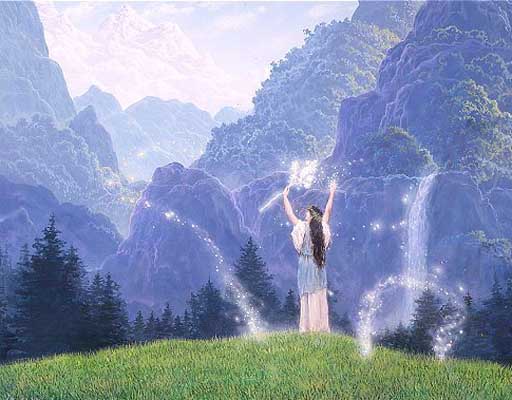
Traditionally, Summer Solstice is celebrated at noon when the sun stands directly overhead and the full force of solar energy can be felt and drawn upon in ritual. One stands beneath the sun, for a while, absorbing the light and heat, and establishing a connection which can be drawn upon in rites later that night.
This is a time of purifying, of cutting through obstacles and drawing on the dynamic power of the God principle to manifest your own power. Lift up your hearts in celebration of the fertility and wonder of life and remember to give thanks for that which has been manifested for you since the last Sabbat.
Many traditions throughout time have celebrated the Solstices, from the times of the ancient and the indigenous people to present day. Bonfires are set on hilltops. People dance around the fires. In many places, after the fire has died away and only the hot coals are remaining, children will be lifted across the coals to be blessed and cleansed by the smoke.
The Summer Solstice is a time to be happy. It is a time to remove unwanted things from your life. It is a time to dance and sing and spread joy and be filled with love.
In the Celtic countries of Northern Europe the Solar Lord fulfilled the same function and in modern times, witches and pagans still honor the Lord of Light, invoking him to "put to flight the powers of darkness" and bring fertility and abundance back to the land and the people. This celebration is a joyous celebration, but at the very height of the Sun's power we also encounter the truth that whatsoever rises must also fall and so from this high point in the solar cycle, the days will begin to grow shorter and the nights longer.
In Britain this theme of transformation from one thing to another was reflected in the story of the Oak King, god of the waxing year and the Holly King, his twin, god of the waning year. It was at this time that the Oak King fell and the Holly King began his reign which would lead inevitably to the darkness of winter and the longest night of the year at the Winter Solstice at which point the Oak King would return. It was said that at the Summer Solstice the Oak King withdrew to the realm of the circumpolar stars, known to the Greeks as the Corona Borealis, to the Egyptians as ik-hem-sek, 'not-knowing-destruction,' and to the Celts as Caer Arianrhod. This region of the stars never disappears below the horizon, not even at the time of Midwinter.
In Ireland music, dancing and story telling were all part of the Solstice celebrations. Before the celebrations could begin, prayers were recited while walking around the bonfire. Herbs gathered on the eve of Summer Solstice were most often used for medicinal purposes. Others were used for rites and divination. St. John's Wort, Elderberries, Yarrow and Vervain were a few that were used. Hazel branches were cut on Solstice eve and used to look for gold, water, and precious jewels. In order for this to work the branches had to be cut between 12 and 1:00 am.
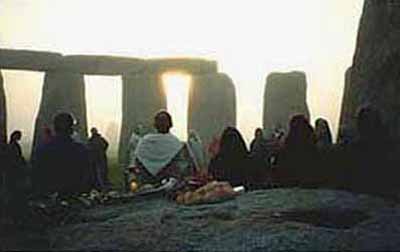
Stonehenge marks the summer solstice
Long ago rituals took place at Stonehenge, on the plain of Salisbury, by the Druid Priests. Contemporary Druids gather at Stonehenge during the summer solstice to watch sunrise over the heelstone and claim their relationship with ancient British ancestors, imagining that they can recapture the essence of archaic ceremonies. Only one heel stone stands now, though some believe that there was another and the sun would rise between the two pillars.
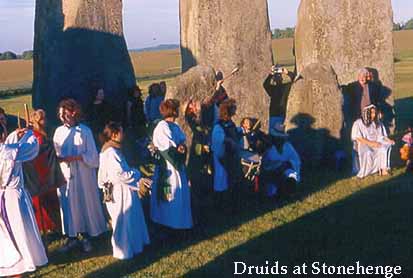
Druids celebrated the Summer Solstice as the wedding of Heaven and Earth. The Goddess manifests as Mother Earth and God as Sun King. Bonfires were lit to celebrate the Sun at its height of power and to ask the Sun not to withdraw into winter darkness. Midsummer Eve festivals in the countryside of Cornwall, England would have firelight shinning from every hill and peak. Dancers adorned in garlands and flowers and young men jumped through the tall flames. This ancient Cornwall Summer Bonfire tradition has been revived during the 1920's and is still a popular festival.
The spiral is a symbol associated with the Solstices and creation by the patterns of sacred geometry. Ancient dances follow the Sun's movement like a spiral. People joined hands weaving through the streets, winding into a decreasing spiral into the middle then unwinding back out again. The Sun moving from contraction at the center of the spiral at winter solstice to expansion at Summer Solstice and back again.
Some call this Midsummer's Eve - one of the three spirit nights of the year, when the veils are thin between the worlds. The others are Beltaine (May Day) and Samhain (October, Celtic New Year).
Midsummer is truly a celebration of the primal creative force of the God at the peak of His powers and the Goddess in Her manifestation as the Mother - fertile and blooming with abundance as the seed of the God quickens within Her. This is a powerful and dynamic Sabbat, as the powers of the union of God and Goddess reach their peak.
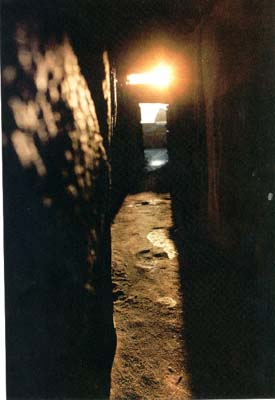
There are many stone sites in the world that are aligned to the Sun's yearly travel. People travel there trying to recreate ancient ceremonial rites that allow for healing. Stonehenge is one of the major places people gather at the time of the summer solstice.
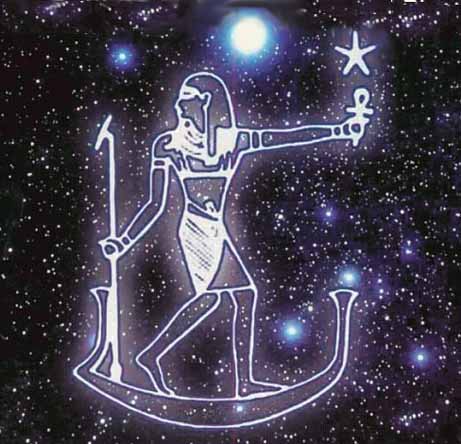
In Ancient Egypt, summer solstice was the most important day of the year. The sun was at its highest and the Nile River was beginning to rise. Inundation of the Nile
Special ceremonies were held to honor the Goddess Isis. Egyptians believed that Isis was mourning for her dead husband, Osiris, and that her tears made the Nile rise and well over.
Accurately predicting the floods was of such vital importance that the appearance of Sirius, which occurs around the time of the summer solstice, was recognized as the beginning of the Egyptian New Year.
In ancient Egyptian mythology, the solar deity Horus defeated his uncle, Set, the Egyptian Lord of darkness and evil at this time of the year. This is linked with rebirth and resurrection. With this victory, divine order and fertility were restored in Egypt and it was thought that this event allowed the Nile floods to come, bringing life back to the Nile valley.
It was the hope of every Pharaoh of Egypt that upon his death he would travel safely through the Duat, the Egyptian afterworld, and "come into the light of day" in the kingdom of Ra, the Sun god, and join with that great god in his solar boat to become one of the imperishable stars. Ra is one of the gods honored at the time of the Summer Solstice along with Horus.
High in the Big Horn Mountains of northern Wyoming, Native Americans once constructed and used a wheel of stones with twenty-eight spokes and a clear summer solstice sunrise alignment. Again, we can not recapture the complete meaning behind this place, but modern Indians and Whites solstice there believing they feel connections to those who made the Bighorn Medicine Wheel. Some light workers worship create their own medicine wheels or go to local ones in Zion Canyon, Sedona, Arizona and others they have declared to be "places of power." They flock to Chaco Canyon to surround Fajada Butte, crystals in hand, humming chants that they imagine to be ancient, singing the Sun across the sky, believing that power can be transmitted into their lives in mystic fashion.
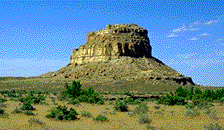
In Chaco Canyon, rising 135 meters above the canyon floor, we find Fajada Butte which contains the well-known three slabs and spiral petroglyphs which mark the cycles of both sun and moon. The 2-3 meter sandstone slabs cast shadows of the late morning and midday sun to indicate both solstices and equinoxes.
When these light and shadow phenomena were first discovered, a vertical shaft of light passed through the center of the spiral at summer solstice.
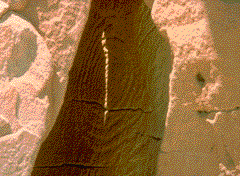
At winter solstice, two noonday daggers framed the large spiral. During the equinoxes, the smaller spiral was bisected at midday by a lesser dagger.
A moonshadow bisects the spiral at moonrise during minor northern standstill and just touches the petroglyph's left edge during major northern standstill. At both places on the petroglyph a straight groove has been pecked which is parallel to the moon's shadow.
Since the groove is parallel to the moon's shadow, it does seem likely that Chacoan astronomers were aware of the major and minor standstills of the moon. The three-slab site is unique in the ancient world in marking on one surface the significant cycles of both the sun and moon.
Within recent years a settling of the slabs has occurred, probably now halted. The beam of light no longer crosses the exact center of the spiral at summer solstice.
One of the double daggers that was initially tangent to the large spiral at winter solstice has disappeared due to a shift by several centimeters of the middle and eastern slabs.
A 230 m long ramp, which may have ascended the 95 m to the top of the butte, appears associated with a Post-Chaco (A. D. 1150-1250) structure on its upper ledges.
A Navajo Story
The primary medicinal plant is mostly emblematic of the spritual deity known as Changing Woman - Asdzaa Nadleehe the woman who is transformed time and again who can take the form of a maiden, a mature woman, or a crone like the three phases of the moon, waxing, full, and waning.
Changing Woman is identified with both creation and protection. She is described in terms of fertility and reproduction by creating mankind from her own epidermis, and subsequently sustaining them through Earth's bounty. She is the First, and pre-emanate Mother. Moreover, she bestowed several things upon mankind, such as certain ceremonies, that would protect humanity from evil forces.
Changing Woman's has a peculiar life cycle. She grows old and becomes young again with the change of the seasons. One might thus interpret her as an allegory of the seasons, but she is more, being related to the earth and vegetation.


In the northern hemisphere, the Summer Solstice begins when the sun enters the sign of Cancer not far from a full moon. Cancer is ruled by the Moon. It rules emotional connectedness, nurturance, compassion, and personal expressions of love. Cancer's symbol resembles, As is above, So is below - spiraling loops in opposite directions.
The United States was created in the sign of Cancer, July 4, 1776. The Crab, coming from water, incorporating Masonic symbology in its design as clues to the destiny of this reality. The Statue of Liberty stands on Liberty Island [water] - just across from Ground Zero in New York City which takes us to the events of 9/11 a metaphor for the ending (9) of our DNA code 11:11. We celebrate US independence two week after the summer solstice. The All Seeing Eye
The universe has always been a blueprint created by Grand Design following the patterns of Sacred Geometry. The heavens are contain encoded messages allowing us to realize our creation beyond the physical and how things move in cycles - or circles - eventually returning to their point of origin. All is myth and metaphor experienced through consciousness in a virtual reality program we view as our current reality.
We see the heavens as a places of creational forces - the gods and goddesses of our reality who one day return to show us the way home. We honor and pray to them in ceremonials that correspond to our belief systems and the flow of nature.
From earliest times people have struggled to understand natural realities, among them the summer and winter solstices. They found interpretations that satisfied their needs, and they used their understanding for improvement of their lives. Differing cultures came into contact and shared their interpretations. Their conclusion would remain until science would explain away the mysteries, much as it does on so many levels today, quantum physics as an example. The program of our reality shows us the true and allows consiousness to evolve through understanding. The patterns and metaphors all contain the answers we week. It is interesting to review old paradigms of thought as move into the new.
Such is the case of the change of seasons and how we have come to understand them and celebrate them onset each year.
Solstices are powerful times. Summer is linked to the sun (male, Leo, Lion) and Winter to the moon (feminine, Aquarius). This goes to the duality of our physical experiment.